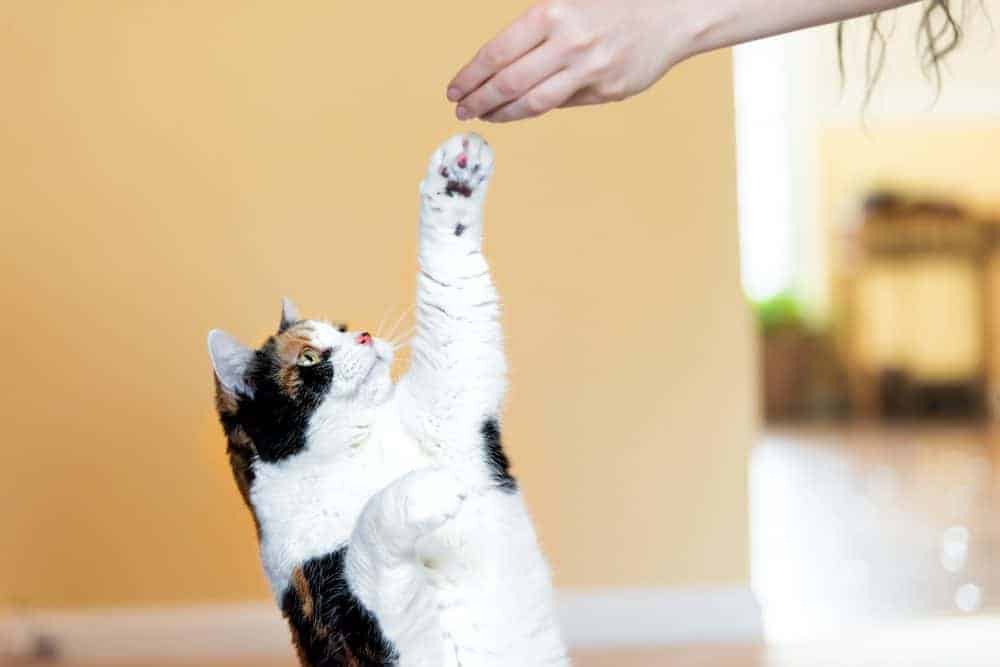
Felines excel at training their human guardians to give them food, attention and a cosy lap to curl up on. But is it possible for us to train them?
Dogs are generally eager and easy to train to sit, lie down and shake paws. Cats, on the other paw, are not renowned for their willingness to respond to requests from their human. However, feline behaviour experts agree that not only is training a cat possible, but it can also provide all sorts of benefits for both feline and humans.
Rehoming charity, Battersea, says: “Despite what you may think, it is possible to train a cat, and training your cat can be useful in lots of practical ways. Basic cat training can help you teach your cat to come to you when called, get them in to a cat carrier as well as feel more comfortable being in one, accept being handled for basic health checks, or to have their claws clipped. Cat training will also have the added bonus of giving you the opportunity to interact with your cat in a positive, productive way that will stimulate your cat and strengthen your bond.”
95% of cat owners want more advice on training their cat, with at least half saying they struggled to get their cat into a cat carrier.
Source: International Cat Care
Cats Protection agrees, stating: “It’s often thought that cats cannot be trained to respond to commands like dogs can, but that isn’t true. With a bit of patience and a few tasty treats you can teach your clever cat to do all sorts of things, such as respond to their name and even sit or lie down when prompted. Training your cat to sit can be very useful for many things, including introducing grooming and handling, and getting them to stay still while you’re preparing their dinner.”
Training is something that feline welfare charity, International Cat Care (iCatCare), is keen to see more cat guardians getting involved in, launching the #BeCatCurious Training for Cats and their Humans campaign on International Cat Day back in August.
Dr Sarah Ellis, iCatCare, Head of Cat Advocacy, explains: “Anyone can train their cat – you don’t need a special cat or training experience. This is the perfect opportunity to introduce owners and cat caregivers across the globe to the concept and start them on their training journey. It’s definitely a bond-enhancing experience!”
How to train your cat
So, if you think training with your cat could be for you, where do you begin? Cats Protection says: “To get started, you will need a physically able and confident cat (older or infirm cats might struggle) a quiet room with no distractions, some tasty treats and a bit of patience.”
Battersea advises: “The best way to train your cat is by using what is known as ‘positive reinforcement’. This means rewarding your cat for performing a desired behaviour. You want your cat to be motivated to learn and feel happy and comfortable doing so. The more the cat feels good about doing something we want them to do, the more likely they are to do it.”
Behaviour shaping
According to feline behaviour experts, successful training is all about shaping their behaviour using positive rewards. Battersea says: “When you are training your cat, you will most often be ‘shaping’ their behaviour by rewarding actions that get closer and closer to the end behaviour you want them to perform. The key to effective cat training is to build up gradually. Identify what you would like them to do, then break this down into small steps, and work through these individually at your cat’s pace.”
Short and sweet
Cats Protection advises: “Throughout training, try to keep sessions to a maximum of three minutes long and then give your cat a break. Be patient and if you find yourself getting frustrated, take a break and come back to it later. Training should be a fun experience for both you and your cat, so always use positive reinforcement and make sure they have the choice to stop if they want to.”
Be cat kind
And remember, patience and kindness are key – never punish your cat if they don’t get something right. Battersea adds: “Punishing your cat won’t help with cat training and may have the opposite effect,” and suggests this plan of action: “If you are teaching your cat to go into the cat carrier of their own accord, you might first simply give the cat a treat for looking in the direction of the carrier. Next you might reward the cat for walking towards the carrier, then for sniffing it, and so on, until the cat reaches the stage where they enter the carrier voluntarily. You can also lure the cat towards the carrier using treats, and place some inside the carrier to encourage your cat to enter. It is important not to overwhelm them or expect too much too soon.”
Remember to:
- Reward your cat as soon as possible after they perform the behaviour you want from them. If you leave the gap too long, then the cat is unlikely to associate the reward (the treat) with the behaviour you want.
- Create a positive association with a specific word or sound. You can do this by saying something like ‘good’, in an upbeat but calm way, and then immediately giving the cat a treat. The more you do this, the more the cat will associate the word ‘good’ with something nice arriving and give you a few more seconds to get the treat ready to give them.
The benefits of positive, reward-based training
iCatCare states: “Training a cat or kitten using rewards reduces stress for everyone. Choose a reward your kitty loves as positive reinforcement for a behaviour, so they’ll do it again. Cats and their humans share a strong curiosity to discover and learn. Learning something new with your cat can strengthen your bond and reduce anxiety for both of you.”
Here are some training ideas to try:
- Training to fetch
We train dogs to pick up things and bring them back so we can throw them again. Cats bring in prey, so carrying back is a natural part of their repertoire, and many of them enjoy becoming involved in a throw-and-retrieve game. By learning how to initiate and maintain contact, they can act out many of their play and hunt behaviours within the safety of their owner’s presence and complete attention.
- Training to ‘talk’
We can encourage our cat to ‘talk’ to us by using food and attention as rewards. Speak to your cat to let them know you want to interact, then encourage them to reply. Make friendly sounds as you prepare their meal, but only let the cat have their food when they have ‘spoken’. The cat will learn to associate ‘asking’ with the reward of food. This interaction is actually a two-way learning/training process – the cat soon becomes a double agent, taking what we have taught and using it for their own ends so that each time they want something they only have to ask!
- Training for safety
If we want to prevent our cats from doing something, such as jumping onto the china shelf or cooker hob, a sharp noise or hiss will stop the cat in its tracks. The ‘sss’ noise is most effective because cats use it themselves to surprise or put off an opponent. Cats soon learn to abandon whatever action they have in mind if you use the ‘sss’ selectively and time it carefully so as to catch them just as they are intent on the act.
Linda Ryan, iCatCare Cat Advocacy Programme Manager, comments: “When we work with cats positively and kindly, there’s so much we can achieve together, including life skills for our cats so they can learn to enjoy having a great life in our care with freedoms and opportunities. Work out what they love, find the things which benefit them, enrich the human-animal bond and have a go at training with your cat!”
Find more cat training tips at Cats Protection >>
Is your cat a Burgess cat? Join the Burgess Pet Club for exclusive offers and rewards.
At Burgess, all our cat food is made using premium ingredients and is high in protein, to ensure excellent quality and superior taste to help keep your cat happy and healthy – from kitten, to adult and mature and our award-winning variety for neutered cats.
If you found this interesting, you may also like:
DOES YOUR CAT KNOW THEIR NAME? Whatever name we choose to bestow upon our beloved pet cats, does it make any difference to them? Do they actually understand that they’re called Alfie or Bella or even Archibald von Snugglemuffin?
ARE YOU AND YOUR CAT MORE ALIKE THAN YOU THINK? It’s long been suggested that people look like their dogs, but when it comes to cats, it seems to be more the case that humans and felines can share similar personality types. So, if you have a grumpy Tabby cat, a super friendly Ragdoll cat, or fiendishly feisty Bengal cat, could this actually say more about you than your pet?
WHEN IT COMES TO COMMUNICATING WITH YOUR CAT, THE EYES HAVE IT ‘How can I communicate with my cat?’ is a question asked by every feline guardian at some point. Well, when it comes to the mysterious task of understanding cat language, focusing on one of a feline’s most appealing features – their captivatingly beautiful eyes – could be the key.
HOW TO STROKE YOUR CAT Question: What’s the best way to stroke your cat? Answer: Probably not the way you’re doing it. And, if you’ve been an ailurophile (cat lover) all your life who knows quite a bit about cat body language, cat behaviour and even cat psychology, this news will probably come as a bit of a shock...
DOES YOUR CAT RECOGNISE YOUR HAPPY FACE? Are cats simply self-absorbed creatures whose relationship with their human is primarily based around the dishing up of cat food? Or, as new research suggests, is there a high level of emotional intelligence going on behind those fabulously enigmatic feline eyes?
IS YOUR CAT IN A FLAP ABOUT MAKING AN ENTRANCE? While most cats cotton on to how cat flaps work with minimal fuss, some felines are rather more suspicious of these curious contraptions and need a little help from their human to show them what to do.
HOW TO PLAY GAMES WITH CATS OF ALL AGES Like all baby animals, kittens love to play. As well as being lots of fun, play teaches young cats about the world around them, aids their physical development and hones their fabulous feline skills. As cats get older, play is a great way to keep fit, lean and healthy, as well as keeping their brain alert and active – something that remains important for the whole of their life.
10 THINGS I HATE ABOUT YOU If our feline friends could tell us what they really think, here’s what they’d probably say about some of the things we do that they’re none too happy about...














